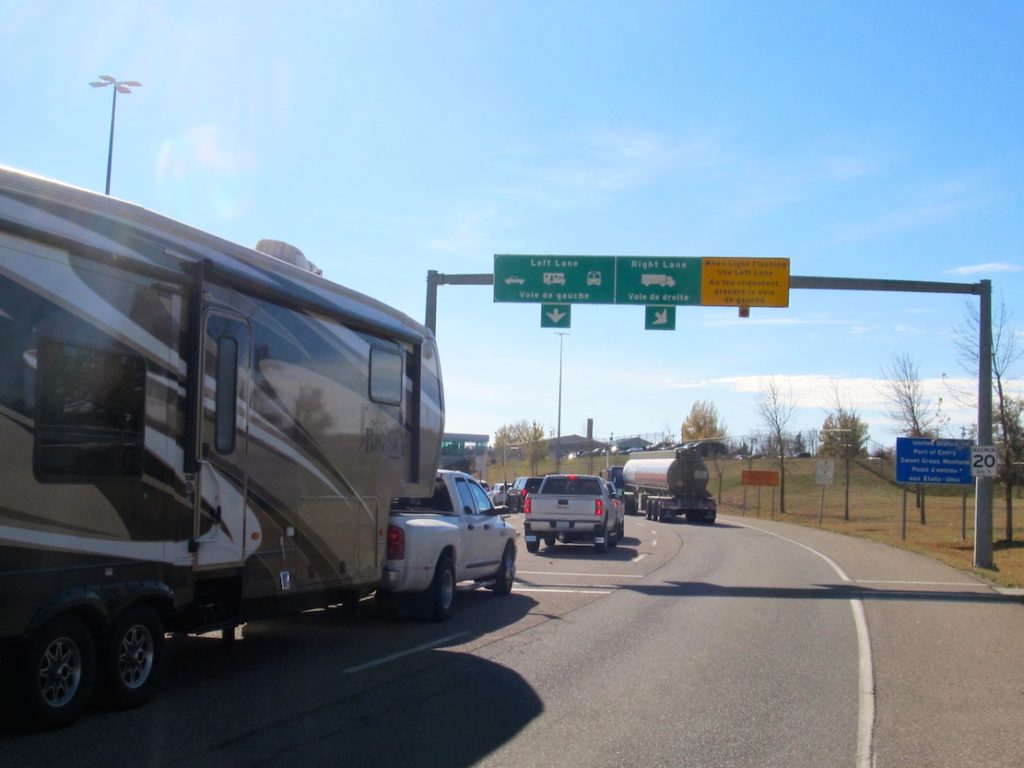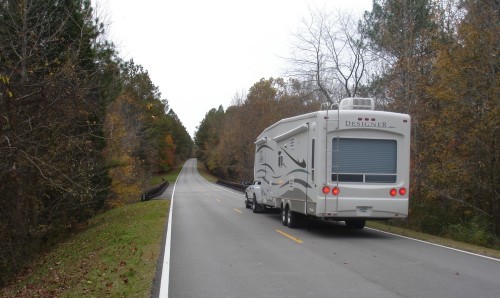
Border crossing at Sweetgrass, Montana
The Canada-United States border is the longest international border in the world: over 5,000 miles with more than 100 highway-crossing points, also known as “ports of entry.” RVers can cross easily in either direction, but need to pay close attention to customs regulations, which differ somewhat depending on which country you are entering. The job of Canadian and U.S. Customs Officers is to ensure that travellers adhere to these regulations.
The level of vigilance at the border will vary depending on the existing level of threat to national security. When you interact with a Customs Officer, just remember that they are very busy keeping our borders safe and secure, and would much rather clear you efficiently than to have to search your RV for a couple of smuggled potatoes! 98% of border crossings are routine and brief. Hopefully, the following information will help ensure that you are part of that group of travellers.
Crossing into the United States
My wife Sandy and I are Canadian full-time RVers who have crossed the border, both ways, dozens of times since we typically snowbird in the south. Just this past fall, we pulled up to a U.S. border-crossing booth and the interaction went exactly like this:
Me: “Hello” while handing the Customs Officer (CO) our passports.
CO: While scanning our passports, “Do either of you have a criminal record?”
Me: “No.”
CO: “How long do you plan to be in the U.S.?”
Me: “Five and a half months.”
CO: “Are you bringing in any alcohol?”
Me: “Two bottles that we bought at the Duty Free Store.”
CO: “Do you have any fruits or vegetables?”
Me: “No”
CO: While handing back our passports, “Have a good trip.”
That’s what I would call “routine and brief!” But occasionally I’ve been part of the 2% that is detained for some reason, depending mostly at the discretion of the Customs Officer.
On one occasion a few years ago, noticing that we had a dog, the U.S. Customs Officer asked that we pull aside so Agriculture Officers could search our RV. We were told to put the dog in an outside pen that they provided and our cat in the shower; then wait inside their office. A half-hour later, they came in with three bags: dog food, cat food, and birdseed. The made-in-Canada dog and cat food contained lamb, which was not permitted in the U.S. Goat would also have been prohibited, unless the packaging indicated the food was made in the U.S. I’m still not sure why they confiscated the birdseed, which we had previously bought in the U.S., but I wasn’t about to argue with a Customs Officer.
In preparation for our next trip south, I called U.S. Customs to inquire about allowable food items. They advised me to contact the Department of Agriculture (USDA) as Customs only enforces USDA guidelines.
The USDA official informed me that meat, except lamb and goat, from Canada is allowed (although a later bout of “mad cow disease” prohibited beef). Fresh fruits grown in the States or Canada are also allowed provided they are “in season” and marked with brand labels. Citrus fruits (oranges, lemons, limes, grapefruit, kumquats, and mandarins) are not allowed. Fresh vegetables are allowed if grown in the U.S. or Canada with the exception of potatoes grown in Canada. Idaho potatoes would be allowed if clearly labeled.
If there is any doubt about the origin, all fruits and vegetables are prohibited. We typically eat several of our last meals with these guidelines in mind. We also restrict alcoholic beverages to one bottle per person to avoid paying duty.
And if you’re carrying firewood in your rig, it might be a good idea to have one last campfire in Canada before crossing the border, as Customs will confiscate it.
Don’t even think about not declaring an agricultural product. A smuggled orange or potato might carry microscopic pests that could devastate the agricultural industry, causing millions of dollars in losses. That’s why the penalties are so severe for smuggling –- up to $50,000 in fines. You, as an RVer, are responsible for knowing the prohibited foods. Even if Customs doesn’t ask, failure to declare your fruits and vegetables may result in a fine. On a typical day, U.S. Customs Service makes over 400 seizures of illegal goods, about 100 of which are food items.
During another of our crossings, I visited the U.S. Customs office and requested a handout of allowable and prohibited food items. Surprisingly, the officer said they didn’t have one because the regulations change from day to day. He did agree they enforce the USDA guidelines, but he didn’t have a handout of those guidelines either.
A year later, I again visited a U.S. Customs office and this time the officer provided me with a handout of the USDA guidelines. When I asked if he would confiscate oranges, he said, “Yes, except those in an unopened package.” Yet, the guidelines state: “Citrus fruits are not allowed.”
Marijuana recently became legal in Canada, but is still illegal in the U.S. Do NOT take marijuana or related products, even for medical use, across the border. Doing so can result in fines and even jail time.
Firearms are also not permitted to cross the border unless they are going to be used for hunting or a shooting competition, in which case you will need to complete a form (6NIA) prior to arriving at the border to receive a permit. Note that processing time could be as long as two or three months. Again, failure to declare can result in fines or even jail time, so it’s best to leave your guns at home.
Crossing into Canada
RVers from the U.S. who visit Canada must be aware of what they can bring into the country. Many of the same rules apply regarding transporting fruits, vegetables, plants, firewood, meats, alcohol, and marijuana. Even though marijuana is legal in Canada, it is illegal to bring it across the border from the States. And, if you carry a firearm in your RV, unless you have a valid reason for bringing it into Canada, leave it south of the border to be picked up when you return. It will be confiscated and not returned if you fail to declare it and a search turns up a firearm.
Once while returning to Canada after spending the winter down south, we were asked to pull over and open our slides. The Canadian Customs Officer confiscated two frozen chicken breasts. I could see confiscating a live chicken, which might spread disease, but a frozen chicken breast? Again, I wasn’t about to argue with a Customs Officer.
On another occasion, we were again asked to open our slides and two officers searched through every nook and cranny. They said we had more than two bottles of wine, but because we lived in our RV, they did not charge duty on the few extras. We also had some bottles of partially consumed liquor, which they said was OK, since they knew it wasn’t being imported for resale. Although we were delayed for an hour or so, at least these guys used their official discretion in our favor … for a change.
Some hints for a routine and brief crossing
Remove your sunglasses and say “hello” to the Customs Officer.
Present your passports immediately, ensuring that they are valid for the duration of time you plan to spend in the country you are visiting.
Have these documents readily available: Driver’s license, vehicle insurance, registration, and rabies-vaccination records if travelling with pets.
Be courteous and answer questions as briefly as possible.
When returning from an RV trip in either country, have a list of goods acquired (including gifts and vehicle repairs) with costs to determine whether you will have to pay duties over a specified amount. (Snowbirds are allowed $800 CAD per person when returning home to Canada).
Have NO fruits and vegetables (unless cut up or cooked), NO plants, NO firewood, NO goat or lamb in the freezer or in pet food, and of course, NO birdseed!
If you have alcoholic beverages in your RV, ensure that they are open and partially consumed … one of the reasons I enjoy crossing the border! Consider purchasing a bottle for each adult at the
Most border crossings have very narrow lanes so drivers of large rigs should use extreme caution, especially with side mirrors extended.
A final word of advice: don’t lie! If you get caught, you could be denied entry to either country on the spot and for multiple future years at the discretion of the Customs Officer. And for most of us, that would put a serious crimp in our RV lifestyle.
Additional useful information
Because of the changing regulations and complicated conditions, consider checking the following websites before crossing the border.
Crossing into the U.S. https://www.cbp.gov/travel/clearing-cbp/bringing-agricultural-products-united-states
Crossing into Canada http://www.inspection.gc.ca/food/information-for-consumers/travellers/what-can-i-bring-into-canada-/eng/1389648337546/1389648516990
Crossing in either direction www.ezbordercrossing.com/travel-resources/government-websites/
